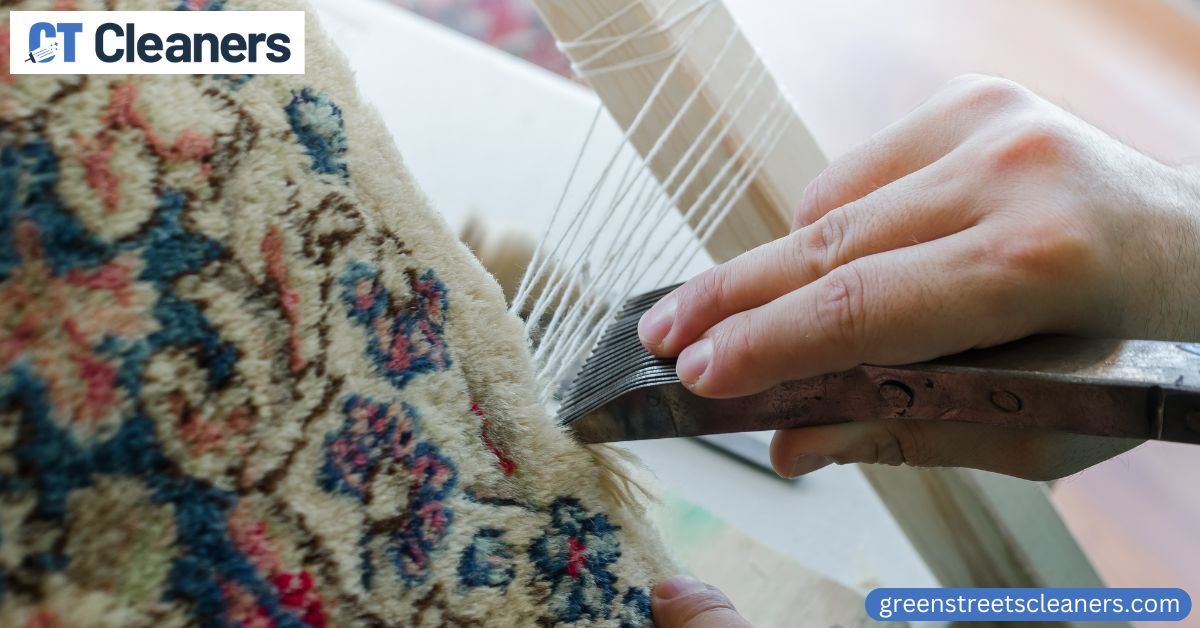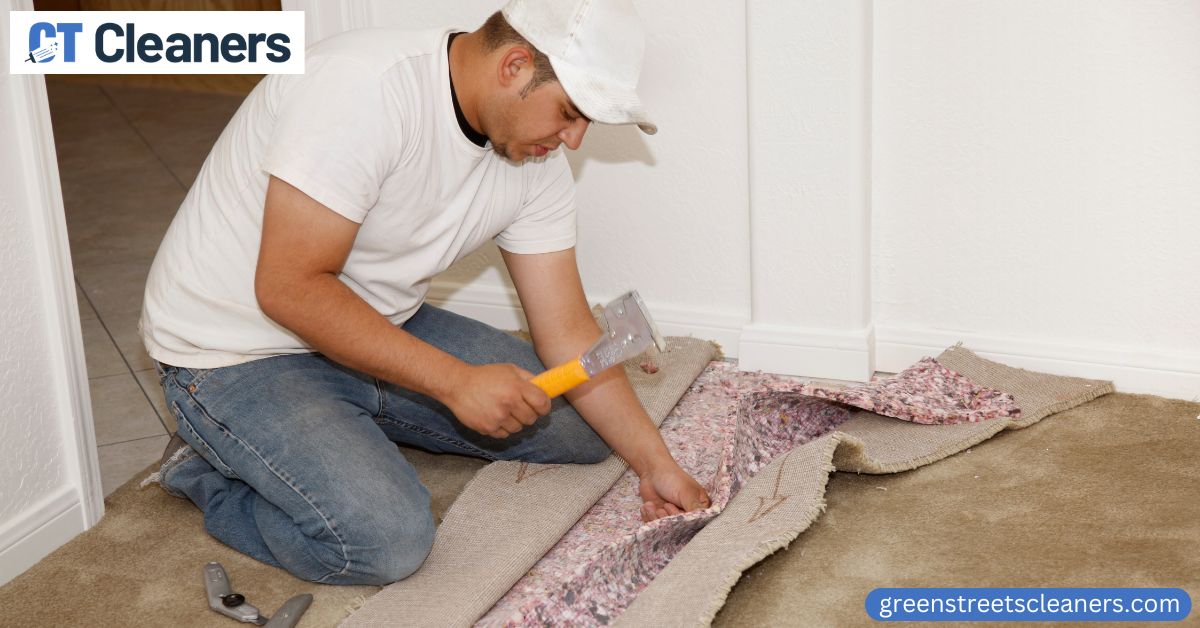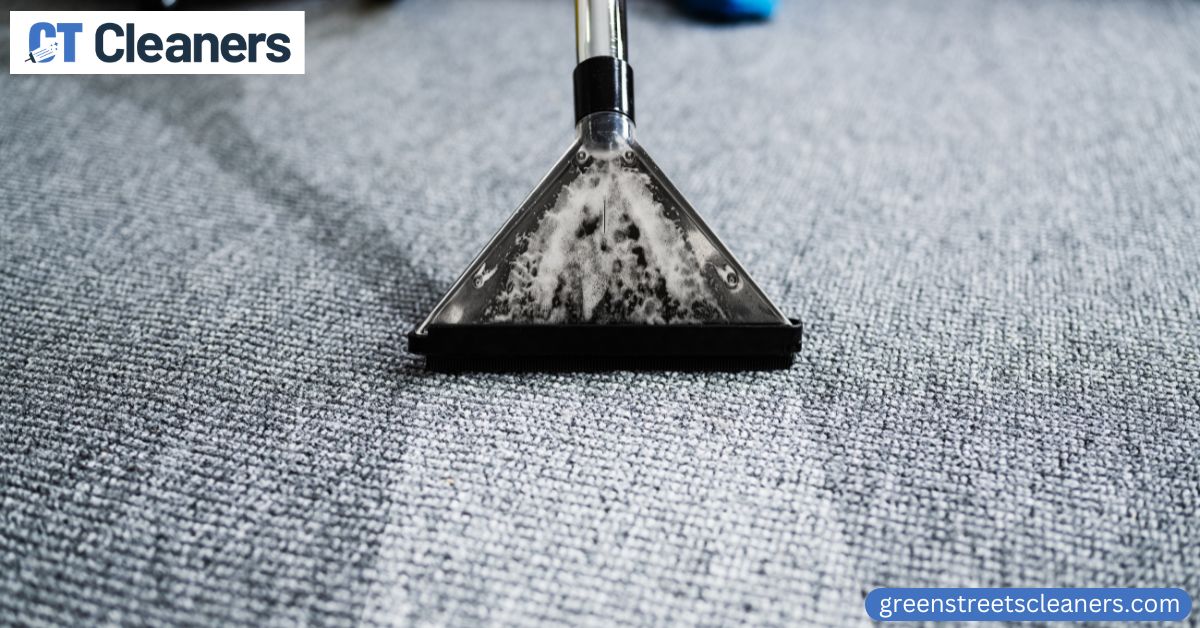With the proper preparation and information, even the most inexperienced individuals can make their carpets look brand new! Carpet repairs don’t have to be daunting; with a bit of guidance, you’ll soon find yourself an expert in no time.
If you’re looking to save a few pennies while returning your carpets back to their original glory, this blog post is for you! We’ll break down the types of carpet damage that need repair, the tools and materials necessary for getting started on restoring them.
Fundamental techniques for fixing it up yourself, preventive measures against future damages, and when best to call in an expert. So if doing-it-yourself appeals to you – keep reading!

Types of Carpet Damage
Different types of damage require different solutions, so it’s important to be able to identify the type of carpet damage you’re dealing with before attempting any repairs.
We will discuss the various types of carpet damage that need repair – from pet accidents and water spills to fading or burns – as well as the materials and tools necessary for getting started on restoring them.
- Stains: caused by spills or other substances that leave marks on the carpet
- Wear and tear: caused by regular foot traffic over time, which can lead to fraying, matting, or bald spots
- Fading: caused by exposure to sunlight, which can cause the colors in the carpet to fade or change
- Burn marks: caused by cigarettes, hot objects, or other sources of heat that can burn the fibers of the carpet
- Water damage: caused by floods, leaks, or other sources of water that can saturate the carpet and lead to mold or mildew growth
- Pet damage: caused by pets scratching or chewing on the carpet, or by accidents that leave stains or odors
- Heavy furniture damage: caused by furniture that is too heavy for the carpet and can leave indentations or other marks
- Improper installation: caused by mistakes made during the installation process, such as wrinkles or buckling in the carpet.

Tools and Materials for Carpet Repair
Whether you’re patching up small holes or replacing large sections of carpet, there are essential supplies to have on hand in order to get the job done efficiently and effectively.
From cutting tools to adhesives, these items will help you achieve professional-looking results while restoring your carpets back to their original condition. With the proper preparation and supplies, you’ll be able to tackle any carpet repair project with confidence.
| Tool/Material | Description |
| Carpet knife |
A sharp knife used to cut and trim carpet
|
| Carpet shears |
Specialized scissors for cutting and shaping carpet
|
| Seam roller |
A tool used to press down seams and edges for a smooth finish
|
| Carpet stretcher |
A tool used to stretch and pull carpet into place during installation or repair
|
| Heat bond tape |
A double-sided adhesive tape used to secure carpet edges and seams
|
| Carpet seam iron |
A tool that uses heat to activate the adhesive on heat bond tape for a strong bond
|
| Carpet seam sealant |
A liquid sealant applied to seams to prevent fraying and unraveling
|
| Carpet patches |
Pre-cut or custom-cut pieces of carpet used to replace damaged areas
|
| Carpet adhesive |
A strong adhesive used to secure patches and attach carpet to subfloor
|
| Knee pads |
Protective pads worn on the knees to prevent injury and discomfort during carpet installation or repair
|
| Utility knife |
A multi-purpose knife used for cutting, trimming, and shaping materials
|
| Staple gun |
A tool used to secure carpet padding and underlayment to the subfloor
|
| Tack strips |
Strips of wood or metal with small nails used to hold carpet in place along edges and corners
|
“Connecticut’s Carpet Fixing gave me the best service I could have asked for – quick, efficient, and high-quality!”
– Kendra C., Belle Haven
Preparation for Carpet Fixing
Preparing your carpet for patching requires some simple steps that can save you a lot of hassle and time. Start by measuring the patch area accurately to determine the amount of patching material you’ll need; this is key to achieving an even patch job.
Once you’ve measured and cut out the patch, vacuum up any loose fibers or dirt to minimize bumps. Then, use fabric glue on the underside of the patch, allowing it to dry before laying it onto the larger carpet.
Finally, apply pressure evenly along the perimeter so that the patch adheres securely in place. Following these steps will ensure a seamless patch job and help extend the life of your beloved carpet!
Basic Carpet Fixing Techniques
Learning rug repair techniques can help keep your carpets looking their best. Making a few simple fixes is often all that’s needed to restore the original appearance of a rug or carpet.
Fixing things like snags, loose ends, and holes in your rug do not require expensive repairs or services. With basic materials and a few tips, you can do most of these repairs yourself.
Start by familiarizing yourself with proper rug-making techniques so you know what could be causing the rug damage. Then gather any supplies like needle and thread, glue, or tape to fix the rug as needed.
Once you have everything together, take your time as you fix small sections of the rug at a time. This may involve stitching, gluing on patches, or tucking back excess rug material where needed until the rug is fixed properly.
Taking care when doing any type of rug repair will save you money and make sure your carpets are kept looking their best for years to come!

Tips for Preventing Carpet Damage
To prevent damage to carpets in your home, maintenance is key. Vacuum regularly—daily or several times a week, depending on foot traffic—to remove dirt and prolong the life of your carpet.
Take care to remove stains promptly with a combination of gentle detergents and spot cleaners; avoid harsh chemicals as these may unintentionally cause further damage to the fibers in your carpet. Additionally, consider using rugs and doormats in your entryways, as these can help remove debris from shoes before it enters your home.
Have furniture pads on the feet of chairs and tables to minimize friction from movement; also rotate large furniture pieces two or three times per year to evenly distribute wear. Following these simple tips for prevention will protect the quality and beauty of carpets in any home.

Hiring a Professional for Carpet Fixing
When your rug begins to look dingy and discolored, it is time to hire a professional rug cleaner in Connecticut. At Carpet Cleaning CT, we use the latest technologies to ensure your rug is cleaned with the utmost care and protection.
Our experienced team of rug cleaners aims to provide exceptional rug cleaning results and treat each rug with respect. We understand that proper rug cleaning requires personal attention.
So we take special care when assessing each rug, ensuring the right cleaning method is used every single time. As leaders in rug cleaning, Carpet Cleaning CT stands apart from others with our commitment to exceptional customer service and quality results.
In conclusion, carpet fixing can be a daunting task for even the most experienced individuals. But with proper preparation and information, it’s possible to make carpets look like new again!
We’ve outlined different types of damage that require repair, essential tools, and materials needed for restoring them, basic techniques for doing-it-yourself repairs, preventive measures against future damages, as well as when best to call in an expert.
With these tips in mind, you’ll soon find yourself becoming an expert at carpet fixing – saving time and money while returning your carpets back to their original glory. So why not give it a try? You may just surprise yourself with how easy it is!







